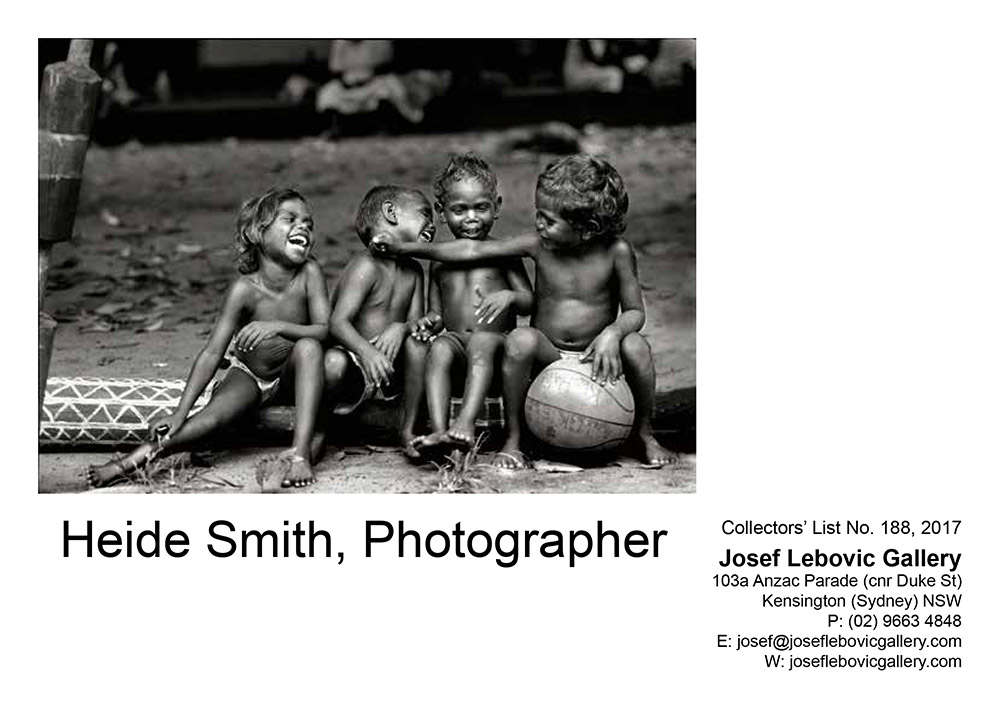Josef Lebovic Catalogue - Heide Smith Photographer

on buying photographs online - a guide
do I need a guide?
Photographs of special events. Many of us have experienced buying photographs from photographers of special events; weddings, school photos, family portraits, even passports. It's fairly simple. You pay a fee, and after the shoot, you order the prints that you like. The only variation is the size of the print, and perhaps the type of frame or album to put it in.
Photographs from a gallery. Buying photograph from a gallery is however, a little more complex. You are entering the world of Vintage Prints, Limited Editions, Open Editions, Analogue versus Digital etc. It is not rocket science, but it is prudent to understand the differences. You are also entering the art world, where a number of different factors affect the value of the photograph. Once again, a basic understanding of these factors could help you avoid an expensive mistake.
Buying photographs online. Buying online can be even more confusing, if only because you don't have an assistant who can answer your questions, but also because online galleries, like people, are all different. Caveat Emptor said the Romans; let the buyer beware.
About the Guide. So first, a look at what some of these words mean; or at least, how we have chosen to interpret them, and then some tips on collecting photographs.
a few definitions
Vintage Photographs. A vintage print is usually described as is "a photograph printed within a very few years of the date when the negative was made". Usually, "a very few years" means two years, but some professionals in this field (including Ansel Adams) say five years. The use of the word "negative" in the definition, implies that an image printed from a digital file cannot be a vintage print, although this may change in the future. Collectors typically place a higher value on a vintage print than a later print, or digital print. You can read a more detailed description in my Vintage Photographs Gallery
Analogue prints. These are prints dating from the pre digital era, They were photographed with an analogue camera and, if black and white, printed on silver gelatin on fibre base or resin coated paper, or , if printed in colour, as CIBA chrome or C type prints. To look at they are very similar to Vintage Prints with one important difference; they were printed more than a couple of years after they were photographed, and thus are very much cheaper than Vintage Prints
Digital Photographs. The first digital camera appeared in 1975, and digital printers were available by the early 1990s, but I didn't "go digital" until about 2000. So, although the image may have been shot on either an analogue or a digital camera, the print has been printed on a digital printer.
Limited Edition Photographs. These are images that I consider to be my best work. They were shot on both analogue and digital cameras, but were printed by me on a digital printer. My limited editions specify that only a stated number of photographs will ever be printed by me of each image in that edition, in a specified size. I have also included some of the images in Folios; usually in a different size. You can read a more detailed description in About My Limited Editions Photographs
Open Edition Photographs. My open edition photographs are digital prints, but, unlike Limited Edition Photographs, there is no limit on the number of photographs that can be printed, thus they are much less expensive than Vintage or Limited Edition photographs. However, almost all of my Open Edition Images have been exhibited, and/or published.
on collecting photographs
Obviously, not everyone who buys our photographs is a collector, but if you follow the steps that most prudent collectors take, you will almost certainly make wiser decisions - and make fewer mistakes. So here are a few ideas.
Decide what you want to collect. Why ? Well, its a bit like stamp collecting. You start off collecting the stamps of every country in the world, and very soon you realize that there are just TOO MANY STAMPS! So you decide to specialize. It might be one or two countries, or a period in history, it might be thematic like sport or butterflies! And photography is the same, TOO MANY PHOTOGRAPHS! So pick a photographer or a topic that really interests you, and start collecting.
Do you really like the image? Very few collectors trade their photographs like shares, buying and selling as the market rises and falls. So the chances are that you will be looking at your photographs for a good few years. And good photographs are so much nicer to look at than share certificates.
Who's the photographer? The "pedigree" of the photographer probably affects the value of your investment more than any other single factor. Are they well known? Have they exhibited, and if so where? Has their work been published? What do the reviewers say?
About the photograph. There are a few things to check;
- Is it dated? Ideally the date it was taken and the date it was printed
- Is it signed? Has it been signed by the photographer, if not, how do know who took it?
- Who printed it? If it is not the photographer, it is usually worth less.
- Is it numbered? How big is the edition? What is the print number. It is usually shown as, say 3/25. Usually, the smaller the edition the higher the price.
- What is it printed on? Is the paper archival? What is it's condition - this will affect the value. Is it mounted?
- Provenance. Does the print have a history, a story behind the image. The identity, or even the notoriety of a sitter ( ie Billy the Kid ), can seriously increase the value. Is there a record of previous ownership?
